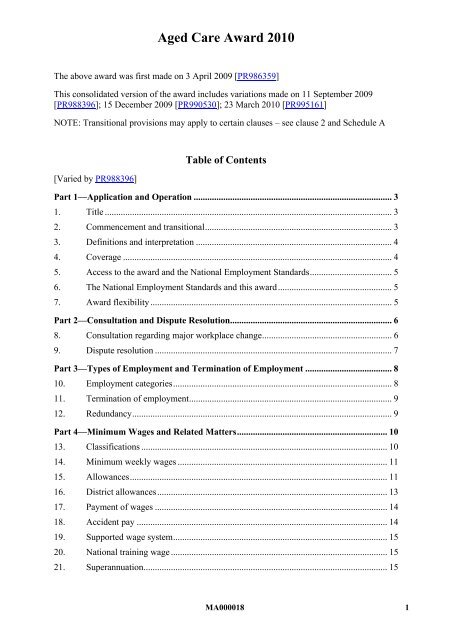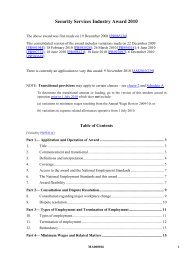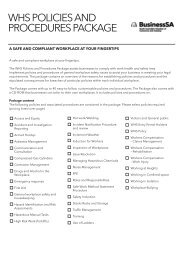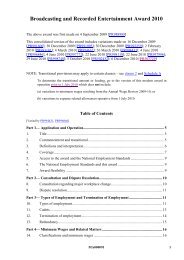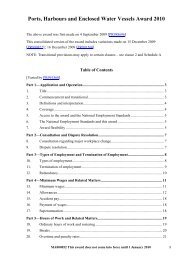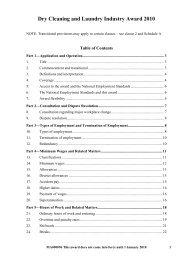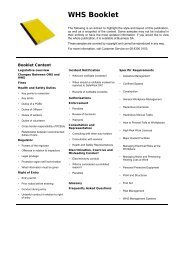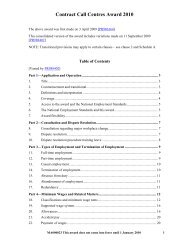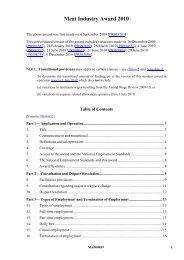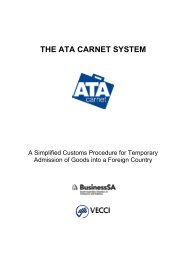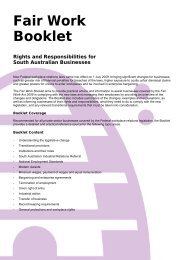Aged Care Award 2010 - Business SA
Aged Care Award 2010 - Business SA
Aged Care Award 2010 - Business SA
You also want an ePaper? Increase the reach of your titles
YUMPU automatically turns print PDFs into web optimized ePapers that Google loves.
<strong>Aged</strong> <strong>Care</strong> <strong>Award</strong> <strong>2010</strong>The above award was first made on 3 April 2009 [PR986359]This consolidated version of the award includes variations made on 11 September 2009[PR988396]; 15 December 2009 [PR990530]; 23 March <strong>2010</strong> [PR995161]NOTE: Transitional provisions may apply to certain clauses – see clause 2 and Schedule ATable of Contents[Varied by PR988396]Part 1—Application and Operation ....................................................................................... 31. Title .............................................................................................................................. 32. Commencement and transitional.................................................................................. 33. Definitions and interpretation ...................................................................................... 44. Coverage ...................................................................................................................... 45. Access to the award and the National Employment Standards.................................... 56. The National Employment Standards and this award.................................................. 57. <strong>Award</strong> flexibility .......................................................................................................... 5Part 2—Consultation and Dispute Resolution....................................................................... 68. Consultation regarding major workplace change......................................................... 69. Dispute resolution ........................................................................................................ 7Part 3—Types of Employment and Termination of Employment ...................................... 810. Employment categories................................................................................................ 811. Termination of employment......................................................................................... 912. Redundancy..................................................................................................................9Part 4—Minimum Wages and Related Matters.................................................................. 1013. Classifications ............................................................................................................ 1014. Minimum weekly wages ............................................................................................ 1115. Allowances................................................................................................................. 1116. District allowances..................................................................................................... 1317. Payment of wages ...................................................................................................... 1418. Accident pay .............................................................................................................. 1419. Supported wage system.............................................................................................. 1520. National training wage ............................................................................................... 1521. Superannuation........................................................................................................... 15MA000018 1
<strong>Aged</strong> <strong>Care</strong> <strong>Award</strong> <strong>2010</strong>Part 5—Hours of Work and Related Matters ..................................................................... 1722. Ordinary hours of work and rostering........................................................................ 1723. Saturday and Sunday work ........................................................................................ 2024. Breaks......................................................................................................................... 2125. Overtime penalty rates ............................................................................................... 2126. Shiftwork.................................................................................................................... 2327. Higher duties .............................................................................................................. 24Part 6—Leave and Public Holidays...................................................................................... 2428. Annual leave .............................................................................................................. 2429. Public holidays........................................................................................................... 2530. Personal/carer’s leave and compassionate leave........................................................ 2631. Community service leave........................................................................................... 2632. Ceremonial Leave ...................................................................................................... 26Schedule A—Transitional Provisions................................................................................... 27Schedule B—Classification Definitions ................................................................................ 31Schedule C—Supported Wage System................................................................................. 36Schedule D—National Training Wage ................................................................................. 392 MA000018
<strong>Aged</strong> <strong>Care</strong> <strong>Award</strong> <strong>2010</strong>Part 1—Application and Operation1. TitleThis award is the <strong>Aged</strong> <strong>Care</strong> <strong>Award</strong> <strong>2010</strong>.2. Commencement and transitional[Varied by PR988396]2.1 This award commences on 1 January <strong>2010</strong>.[2.2–2.6 inserted by PR988396]2.2 The monetary obligations imposed on employers by this award may be absorbed intooveraward payments. Nothing in this award requires an employer to maintain orincrease any overaward payment.2.3 This award contains transitional arrangements which specify when particular parts ofthe award come into effect. Some of the transitional arrangements are in clauses inthe main part of the award. There are also transitional arrangements in Schedule A.The arrangements in Schedule A deal with:• minimum wages and piecework rates• casual or part-time loadings• Saturday, Sunday, public holiday, evening or other penalties• shift allowances/penalties.2.4 Neither the making of this award nor the operation of any transitional arrangementsis intended to result in a reduction in the take-home pay of employees covered by theaward. On application by or on behalf of an employee who suffers a reduction intake-home pay as a result of the making of this award or the operation of anytransitional arrangements, Fair Work Australia may make any order it considersappropriate to remedy the situation.2.5 Fair Work Australia may review the transitional arrangements in this award andmake a determination varying the award.2.6 Fair Work Australia may review the transitional arrangements:(a)(b)(c)on its own initiative; oron application by an employer, employee, organisation or outworker entitycovered by the modern award; oron application by an organisation that is entitled to represent the industrialinterests of one or more employers or employees that are covered by themodern award; orMA000018 3
<strong>Aged</strong> <strong>Care</strong> <strong>Award</strong> <strong>2010</strong>4.4 Where an employer is covered by more than one award, an employee of thatemployer is covered by the award classification which is most appropriate to thework performed by the employee and to the environment in which the employeenormally performs the work.NOTE: Where there is no classification for a particular employee in this award it ispossible that the employer and that employee are covered by an award withoccupational coverage.5. Access to the award and the National Employment StandardsThe employer must ensure that copies of this award and the NES are available to allemployees to whom they apply either on a noticeboard which is conveniently located at ornear the workplace or through electronic means, whichever makes them more accessible.6. The National Employment Standards and this awardThe NES and this award contain the minimum conditions of employment for employeescovered by this award.7. <strong>Award</strong> flexibility7.1 Notwithstanding any other provision of this award, an employer and an individualemployee may agree to vary the application of certain terms of this award to meet thegenuine individual needs of the employer and the individual employee. The terms theemployer and the individual employee may agree to vary the application of are thoseconcerning:(a)(b)(c)(d)(e)arrangements for when work is performed;overtime rates;penalty rates;allowances; andleave loading.7.2 The employer and the individual employee must have genuinely made the agreementwithout coercion or duress.7.3 The agreement between the employer and the individual employee must:(a)(b)be confined to a variation in the application of one or more of the terms listedin clause 7.1; andresult in the employee being better off overall than the employee would havebeen if no individual flexibility agreement had been agreed to.7.4 The agreement between the employer and the individual employee must also:MA000018 5
<strong>Aged</strong> <strong>Care</strong> <strong>Award</strong> <strong>2010</strong>(a)(b)(c)(d)(e)be in writing, name the parties to the agreement and be signed by the employerand the individual employee and, if the employee is under 18 years of age, theemployee’s parent or guardian;state each term of this award that the employer and the individual employeehave agreed to vary;detail how the application of each term has been varied by agreement betweenthe employer and the individual employee;detail how the agreement results in the individual employee being better offoverall in relation to the individual employee’s terms and conditions ofemployment; andstate the date the agreement commences to operate.7.5 The employer must give the individual employee a copy of the agreement and keepthe agreement as a time and wages record.7.6 Except as provided in clause 7.4(a) the agreement must not require the approval orconsent of a person other than the employer and the individual employee.7.7 An employer seeking to enter into an agreement must provide a written proposal tothe employee. Where the employee’s understanding of written English is limited theemployer must take measures, including translation into an appropriate language, toensure the employee understands the proposal.7.8 The agreement may be terminated:(a)(b)by the employer or the individual employee giving four weeks’ notice oftermination, in writing, to the other party and the agreement ceasing to operateat the end of the notice period; orat any time, by written agreement between the employer and the individualemployee.7.9 The right to make an agreement pursuant to this clause is in addition to, and is notintended to otherwise affect, any provision for an agreement between an employerand an individual employee contained in any other term of this award.Part 2—Consultation and Dispute Resolution8. Consultation regarding major workplace change8.1 Employer to notify(a)(b)Where an employer has made a definite decision to introduce major changes inproduction, program, organisation, structure or technology that are likely tohave significant effects on employees, the employer must notify the employeeswho may be affected by the proposed changes and their representatives, if any.Significant effects include termination of employment; major changes in thecomposition, operation or size of the employer’s workforce or in the skillsrequired; the elimination or diminution of job opportunities, promotion6 MA000018
<strong>Aged</strong> <strong>Care</strong> <strong>Award</strong> <strong>2010</strong>opportunities or job tenure; the alteration of hours of work; the need forretraining or transfer of employees to other work or locations; and therestructuring of jobs. Provided that where this award makes provision foralteration of any of these matters an alteration is deemed not to have significanteffect.8.2 Employer to discuss change(a)(b)(c)The employer must discuss with the employees affected and theirrepresentatives, if any, the introduction of the changes referred to in clause 8.1,the effects the changes are likely to have on employees and measures to avertor mitigate the adverse effects of such changes on employees and must giveprompt consideration to matters raised by the employees and/or theirrepresentatives in relation to the changes.The discussions must commence as early as practicable after a definite decisionhas been made by the employer to make the changes referred to in clause 8.1.For the purposes of such discussion, the employer must provide in writing tothe employees concerned and their representatives, if any, all relevantinformation about the changes including the nature of the changes proposed,the expected effects of the changes on employees and any other matters likelyto affect employees provided that no employer is required to discloseconfidential information the disclosure of which would be contrary to theemployer’s interests.9. Dispute resolution9.1 In the event of a dispute about a matter under this award, or a dispute in relation tothe NES, in the first instance the parties must attempt to resolve the matter at theworkplace by discussions between the employee or employees concerned and therelevant supervisor. If such discussions do not resolve the dispute, the parties willendeavour to resolve the dispute in a timely manner by discussions between theemployee or employees concerned and more senior levels of management asappropriate.9.2 If a dispute about a matter arising under this award or a dispute in relation to the NESis unable to be resolved at the workplace, and all appropriate steps under clause 9.1have been taken, a party to the dispute may refer the dispute to the Commission.9.3 The parties may agree on the process to be utilised by the Commission includingmediation, conciliation and consent arbitration.9.4 Where the matter in dispute remains unresolved, the Commission may exercise anymethod of dispute resolution permitted by the Act that it considers appropriate toensure the settlement of the dispute.9.5 An employer or employee may appoint another person, organisation or association toaccompany and/or represent them for the purposes of this clause.9.6 While the dispute resolution procedure is being conducted, work must continue inaccordance with this award and the Act. Subject to applicable occupational healthand safety legislation, an employee must not unreasonably fail to comply with aMA000018 7
<strong>Aged</strong> <strong>Care</strong> <strong>Award</strong> <strong>2010</strong>direction by the employer to perform work, whether at the same or anotherworkplace, that is safe and appropriate for the employee to perform.Part 3—Types of Employment and Termination of Employment10. Employment categories[Varied by PR995161]10.1 Employees under this award will be employed in one of the following categories:(a)(b)(c)full-time;part-time; orcasual.At the time of engagement an employer will inform each employee whether they areemployed on a full-time, part-time or casual basis. An employer may direct anemployee to carry out such duties that are within the limits of the employee’s skill,competence and training, consistent with the respective classification.10.2 Full-time employeesA full-time employee is one who is engaged to work 38 hours per week or anaverage of 38 hours per week pursuant to clause 22.1 of this award.10.3 Part-time employees(a)(b)A part-time employee is an employee who is engaged to work less than fulltimehours of an average of 38 hours per week and has reasonably predictablehours of work.Before commencing employment, the employer and employee will agree inwriting on a regular pattern of work including the number of hours to beworked each week, the days of the week the employee will work and thestarting and finishing times each day.[10.3(c) substituted by PR995161 ppc 23Mar10](c)(d)(e)Any agreed variation to the hours of work will be in writing.The terms of this award will apply on a pro rata basis to part-time employeeson the basis that the ordinary weekly hours for full-time employees are 38.Payment in respect of personal/carer’s leave (where an employee hasaccumulated an entitlement) for a part-time employee will be on a pro ratabasis made according to the number of hours the employee would have workedon the day or days on which the leave was taken so as not to reduce theemployee’s wage below that level which the employee would have receivedhad the employee not been absent.8 MA000018
<strong>Aged</strong> <strong>Care</strong> <strong>Award</strong> <strong>2010</strong>10.4 Casual employees(a)(b)A casual employee is an employee engaged as such on an hourly basis, otherthan as a part-time, full-time or fixed term employee, to work up to andincluding 38 ordinary hours per week.A casual employee will be paid per hour worked at the rate of 1/38th of theweekly rate appropriate to the employee’s classification. In addition, a loadingof 25% of that rate will be paid instead of the paid leave entitlements accruedby full-time employees.11. Termination of employment11.1 Notice of termination is provided for in the NES.11.2 Notice of termination by an employeeThe notice of termination required to be given by an employee is the same as thatrequired of an employer except that there is no requirement on the employee to giveadditional notice based on the age of the employee concerned. If an employee fails togive the required notice the employer may withhold from any monies due to theemployee on termination under this award or the NES, an amount not exceeding theamount the employee would have been paid under this award in respect of the periodof notice required by this clause less any period of notice actually given by theemployee.11.3 Job search entitlementWhere an employer has given notice of termination to an employee, an employeemust be allowed up to one day’s time off without loss of pay for the purpose ofseeking other employment. The time off is to be taken at times that are convenient tothe employee after consultation with the employer.12. Redundancy12.1 Redundancy pay is provided for in the NES.12.2 Transfer to lower paid dutiesWhere an employee is transferred to lower paid duties by reason of redundancy, thesame period of notice must be given as the employee would have been entitled to ifthe employment had been terminated and the employer may, at the employer’soption, make payment instead of an amount equal to the difference between theformer ordinary time rate of pay and the ordinary time rate of pay for the number ofweeks of notice still owing.12.3 Employee leaving during notice periodAn employee given notice of termination in circumstances of redundancy mayterminate their employment during the period of notice. The employee is entitled toreceive the benefits and payments they would have received under this clause hadthey remained in employment until the expiry of the notice, but is not entitled topayment instead of notice.MA000018 9
<strong>Aged</strong> <strong>Care</strong> <strong>Award</strong> <strong>2010</strong>12.4 Job search entitlement(a)(b)An employee given notice of termination in circumstances of redundancy mustbe allowed up to one day’s time off without loss of pay during each week ofnotice for the purpose of seeking other employment.If the employee has been allowed paid leave for more than one day during thenotice period for the purpose of seeking other employment, the employee must,at the request of the employer, produce proof of attendance at an interview orthey will not be entitled to payment for the time absent. For this purpose astatutory declaration is sufficient.(c) This entitlement applies instead of clause 11.3.12.5 Transitional provisions(a)Subject to clause 12.5(b), an employee whose employment is terminated by anemployer is entitled to redundancy pay in accordance with the terms of aNAP<strong>SA</strong>:(i)(ii)that would have applied to the employee immediately prior to 1 January<strong>2010</strong>, if the employee had at that time been in their current circumstancesof employment and no agreement made under the Act had applied to theemployee; andthat would have entitled the employee to redundancy pay in excess of theemployee’s entitlement to redundancy pay, if any, under the NES.(b)(c)The employee’s entitlement to redundancy pay under the NAP<strong>SA</strong> is limited tothe amount of redundancy pay which exceeds the employee’s entitlement toredundancy pay, if any, under the NES.This clause does not operate to diminish an employee’s entitlement toredundancy pay under any other instrument.(d) Clause 12.5 ceases to operate on 31 December 2014.Part 4—Minimum Wages and Related Matters13. Classifications[Sched A renumbered as Sched B by PR988396]All employees covered by this award must be classified according to the structure anddefinitions set out in Schedule B—Classification Definitions. Employers must advise theiremployees in writing of their classification upon commencement and of any subsequentchanges to their classification.10 MA000018
<strong>Aged</strong> <strong>Care</strong> <strong>Award</strong> <strong>2010</strong>employment and no agreement made under that Act had applied to theemployee; and(b)that would have entitled the employee to payment of a district allowance.16.2 Western Australia and QueenslandAn employee in Western Australia or Queensland is entitled to payment of a districtallowance in accordance with the terms of a NAP<strong>SA</strong> or an award made under theWorkplace Relations Act 1996 (Cth):(a) that would have applied to the employee immediately prior to 1 January <strong>2010</strong>,if the employee had at that time been in their current circumstances ofemployment and no agreement made under that Act had applied to theemployee; and(b)that would have entitled the employee to payment of a district allowance.16.3 This clause ceases to operate on 31 December 2014.17. Payment of wagesWages are to be paid weekly or fortnightly.17.1 Method of paymentSubject to clause 17.3, by no later than payday, wages must be paid by cash orelectronic funds transfer, the latter into the bank or financial institutional accountnominated by the employee.17.2 Termination17.3 DelayWhen notice of termination of employment has been given by an employee or anemployee’s services have been terminated by an employer, payment of all wages andother moneys owing to an employee will be made to the employee by no later thanthe last day of the formal notice period.Notwithstanding the above, an employer will not be held liable for any unforeseenevent outside the control of the employer which prevents the employer’s ability tomeet the requirements of this clause, for example bank error or delay.18. Accident pay18.1 Subject to clause 18.2, an employee is entitled to accident pay in accordance with theterms of:(a)a NAP<strong>SA</strong> that would have applied to the employee immediately prior to1 January <strong>2010</strong> or an award made under the Workplace Relations Act 1996(Cth) that would have applied to the employee immediately prior to27 March 2006, if the employee had at that time been in their currentcircumstances of employment and no agreement made under the WorkplaceRelations Act 1996 (Cth) had applied to the employee; and14 MA000018
<strong>Aged</strong> <strong>Care</strong> <strong>Award</strong> <strong>2010</strong>(b)that would have entitled the employee to accident pay in excess of theemployee’s entitlement to accident pay, if any, under any other instrument.18.2 The employee’s entitlement to accident pay under the NAP<strong>SA</strong> or award is limited tothe amount of accident pay which exceeds the employee’s entitlement to accidentpay, if any, under any other instrument.18.3 This clause does not operate to diminish an employee’s entitlement to accident payunder any other instrument.18.4 This clause ceases to operate on 31 December 2014.19. Supported wage system[Sched B renumbered as Sched C by PR988396]See Schedule C20. National training wage[Sched C renumbered as Sched D by PR988396]See Schedule D21. Superannuation[Varied by PR990530, PR995161]21.1 Superannuation legislation(a) Superannuation legislation, including the Superannuation Guarantee(Administration) Act 1992 (Cth), the Superannuation Guarantee Charge Act1992 (Cth), the Superannuation Industry (Supervision) Act 1993 (Cth) and theSuperannuation (Resolution of Complaints) Act 1993 (Cth), deals with thesuperannuation rights and obligations of employers and employees. Undersuperannuation legislation individual employees generally have the opportunityto choose their own superannuation fund. If an employee does not choose asuperannuation fund, any superannuation fund nominated in the awardcovering the employee applies.(b)The rights and obligations in these clauses supplement those in superannuationlegislation.21.2 Employer contributionsAn employer must make such superannuation contributions to a superannuation fundfor the benefit of an employee as will avoid the employer being required to pay thesuperannuation guarantee charge under superannuation legislation with respect tothat employee.MA000018 15
21.3 Voluntary employee contributions<strong>Aged</strong> <strong>Care</strong> <strong>Award</strong> <strong>2010</strong>(a)(b)(c)Subject to the governing rules of the relevant superannuation fund, anemployee may, in writing, authorise their employer to pay on behalf of theemployee a specified amount from the post-taxation wages of the employeeinto the same superannuation fund as the employer makes the superannuationcontributions provided for in clause 21.2.An employee may adjust the amount the employee has authorised theiremployer to pay from the wages of the employee from the first of the monthfollowing the giving of three months’ written notice to their employer.The employer must pay the amount authorised under clauses 21.3(a) or (b) nolater than 28 days after the end of the month in which the deduction authorisedunder clauses 21.3(a) or (b) was made.21.4 Superannuation fundUnless, to comply with superannuation legislation, the employer is required to makethe superannuation contributions provided for in clause 21.2 to anothersuperannuation fund that is chosen by the employee, the employer must make thesuperannuation contributions provided for in clause 21.2 and pay the amountauthorised under clauses 21.3(a) or (b) to one of the following superannuation funds:(a)(b)(c)(d)(e)First State Super;Health Industry Plan (HIP);Health Employees Superannuation Trust of Australia (HESTA);Health Super;National Catholic Superannuation Fund;[21.4(f) substituted by PR990530](f)(g)(h)(i)Mercy Super;Sunsuper;Tasplan;Australian Superannuation Savings Employment Trust (Asset Super);[21.4(j) varied by PR995161 ppc 23Mar10](j)UC Super;[21.4(k) inserted by PR995161 ppc 23Mar10](k)AustralianSuper; or[21.4(k) renumbered as 21.4(l) by PR995161 ppc 23Mar10](l)any superannuation fund to which the employer was making superannuationcontributions for the benefit of its employees before 12 September 2008,provided the superannuation fund is an eligible choice fund.16 MA000018
<strong>Aged</strong> <strong>Care</strong> <strong>Award</strong> <strong>2010</strong>Part 5—Hours of Work and Related Matters22. Ordinary hours of work and rostering[Varied by PR995161]22.1 Ordinary hours of workThe ordinary hours of work will be 38 hours per week, or an average of 38 hours perweek worked over 76 hours per fortnight or 114 hours per 21 days or 152 hours perfour week period, and will be worked either:(a)(b)(c)in a period of 28 calendar days of not more than 20 work days in a roster cycle;in a period of 28 calendar days of not more than 19 work days in a roster cycle,with the twentieth day taken as an accrued paid day off (ADO); oreight hours on a day shift or 10 hours on a night shift.22.2 Span of hours(a)(b)The ordinary hours of work for a day worker will be worked between 6.00 amand 6.00 pm Monday to Friday.A shiftworker is an employee who is regularly rostered to work their ordinaryhours outside the ordinary hours of work of a day worker, as defined in clause22.1(a).22.3 Rostered days offEmployees, other than a casual employee, will be free from duty for not less thantwo full days in each week or four full days in each fortnight or eight full days ineach 28 day cycle. Where practicable, days off will be consecutive.22.4 Rest breaks between rostered work(a)(b)An employee will be allowed a break of not less than 10 hours between thetermination of one shift or period of duty and the commencement of another.By mutual agreement, the 10 hour rest break may be reduced to eight hours.22.5 Accumulation and taking of accrued days off (ADOs)(a)(b)(c)(d)This clause will only apply to full-time employees.Where an employee is entitled to an ADO in accordance with the arrangementof ordinary hours of work as set out in clause 22.1, ADOs will be taken within12 months of the date on which the first full ADO accrued.Where an employee’s employment terminates for any reason, accumulatedADOs will be paid to the employee at ordinary rates.The taking of an employee’s ADO will be determined, by mutual agreementbetween the employee and the employer, having regard to the needs of theplace of employment or sections thereof. Such ADO will, where practicable, beMA000018 17
22.6 Rosters<strong>Aged</strong> <strong>Care</strong> <strong>Award</strong> <strong>2010</strong>consecutive with the rostered days off prescribed in clause 22.3 above. ADOswill not be rostered on public holidays.(a)(b)(c)(d)(e)(f)(g)The ordinary hours of work for each employee will be displayed on a roster ina place conveniently accessible to employees. Such roster will be displayed atleast two weeks prior to the commencing date of the first working period in anyroster subject to clause 22.6(c) below.In the case of homecare employees, alternative means of communicatingchange of rosters such as telephone communication, direct contact, mail orfacsimile will be accepted.It is not obligatory for the employer to display any roster of the ordinary hoursof work of casual or relieving staff.Seven days notice will be given of a change in a roster. However, a roster maybe altered at any time to enable the service of the organisation to be carried onwhere another employee is absent from duty on account of illness or in anemergency.This clause will not apply where the only change to the roster of a part-timeemployee is the mutually agreed addition of extra hours to be worked such thatthe part-time employee still has two rostered days off in that week or fourrostered days off in that fortnight, as the case may be.Where practicable, ADOs will be displayed on the roster.This clause will not apply to hostel supervisors.22.7 Minimum engagements(a)(b)(c)(d)Full-time employees will receive a minimum payment of four hours for eachengagement in respect of ordinary hours of work.Permanent part-time and casual employees, other than homecare employees,will receive a minimum payment of two hours for each engagement.Permanent part-time homecare employees and casual homecare employees willreceive a minimum of one hour for each engagement.Subject to clause 22.8, except for meal breaks, the hours of work on any daywill be continuous.22.8 Broken shiftsWith respect to broken shifts:(a)Broken shift for the purposes of this clause means a shift worked by a casualor permanent part-time employee that includes breaks (other than a meal break)totalling not more than four hours and where the span of hours is not more than12 hours.18 MA000018
[22.8(b) varied by PR995161 ppc 23Mar10]<strong>Aged</strong> <strong>Care</strong> <strong>Award</strong> <strong>2010</strong>(b)(c)(d)(e)A broken shift may be worked where there is mutual agreement between theemployer and employee to work the broken shift.Payment for a broken shift will be at ordinary pay with penalty rates and shiftallowances in accordance with clause 25—Overtime penalty rates, with shiftallowances being determined by the commencing time of the broken shift.All work performed beyond the maximum span of 12 hours for a broken shiftwill be paid at double time.An employee must receive a minimum break of 10 hours between broken shiftsrostered on successive days.22.9 SleepoversEmployees may, in addition to normal rostered shifts, be required to sleepover.A sleepover means sleeping in at night in order to be on call for emergencies.The following conditions will apply to each night of sleepover:(a)(b)(c)(d)(e)(f)(g)The span for a sleepover will be not less than eight hours and not more than10 hours on any one night.Employees will be provided with free board and lodging for each night onwhich they are required to sleepover.Employees will be provided with a separate room with a bed and use of stafffacilities or client facilities where applicable.In addition to the provision of free board and lodging for sleepovers, theemployee will be entitled to a sleepover allowance of $36.00 for each night onwhich they sleep over.No work other than that of an emergency nature will be required to beperformed during any sleepover. For the purposes of this clause an emergencyis any unplanned occurrence or event requiring prompt action.An employee directed to perform work other than that of an emergency natureduring any sleepover will be paid the appropriate hourly rate from the start ofthe sleepover to the end of the non-emergency work, or from the start of thenon-emergency work to the end of the sleepover, whichever is the lesser, inaddition to the sleepover allowance in clause 22.9(d).All time worked during any sleepover will count as time worked and be paidfor in accordance with the following provisions:(i)(ii)All time worked by full-time employees during any sleepover will bepaid for at overtime rates.All time worked by permanent part-time employees during any sleepoverwill be paid for at ordinary pay plus applicable shift and weekendpenalties; provided that, if the total number of hours worked on that dayexceeds the number of hours worked by full-time employees, or 11 hourswhere there are no such full-time employees, then the excess hoursMA000018 19
<strong>Aged</strong> <strong>Care</strong> <strong>Award</strong> <strong>2010</strong>worked on that day will be paid for at overtime rates; and providedfurther that if the total number of hours worked in the week exceeds 38hours, or exceeds 76 hours in the fortnight, then the excess hours workedin that week or fortnight will be paid for at overtime rates.(iii) All time worked by casual employees during any sleepover will be paidfor at ordinary pay plus applicable shift and weekend penalties; providedthat if the total number of hours worked in the week exceeds 38 hours, orexceeds 76 hours in the fortnight, then the excess hours worked in thatweek or fortnight will be paid for at overtime rates.(iv) And provided further that where the employee does not have eightconsecutive hours off duty between ordinary rostered duty on successivedays, then the provisions of clause 22.9(j) will apply.(h)(i)(j)(k)A sleepover may be rostered to commence immediately at the conclusion of theemployee’s shift and continuous with that shift; and/or immediately prior to theemployee’s shift and continuous with that shift, and not otherwise.No employee will be required to sleepover during any part of their rostereddays off or ADOs.An employee (whether a full-time employee, permanent part-time employee orcasual employee) who performs so much work during sleepover periodsbetween the termination of their ordinary work on any day or shift and thecommencement of their ordinary work on the next day or shift that they havenot had at least eight consecutive hours off duty between these times will,subject to this clause, be released after completion of such work until they havehad eight consecutive hours off duty without loss of pay for ordinary workingtime occurring during such absence. If, on the instruction of the employer, suchan employee resumes or continues to work without having eight consecutivehours off duty, the employee will be paid at double the appropriate rate untilthey are released from duty for eight consecutive hours and will be entitled tobe absent until they have had 10 consecutive hours off duty without loss of payfor ordinary working time occurring during such absence.Casual employees may only be used for sleepovers when full-time employeesor permanent part-time employees are not available for that duty. In no casewill casual employees be used exclusively, or almost exclusively, forsleepovers.Nothing in this clause will preclude the employer from rostering an employee towork shift work instead of undertaking sleepovers.23. Saturday and Sunday work[Varied by PR995161]23.1 Employees whose ordinary working hours include work on a Saturday and/orSunday, will be paid for ordinary hours worked between midnight on Friday andmidnight on Saturday at the rate of time and a half, and for ordinary hours workedbetween midnight on Saturday and midnight on Sunday at the rate of time and three20 MA000018
<strong>Aged</strong> <strong>Care</strong> <strong>Award</strong> <strong>2010</strong>(i)(ii)for all authorised overtime on Monday to Friday, payment will be madeat the rate of time and a half for the first two hours and double timethereafter;for all authorised overtime on a Saturday or Sunday, payment will bemade at the rate of double time; and(iii) for all authorised overtime on a public holiday, payment will be made atthe rate of double time and a half.Overtime rates under this clause will be in substitution for, and not cumulativeupon, the shift premiums prescribed in clause 26.1.[25.1(b) varied by PR995161 ppc 23Mar10](b)Part-time and casual employees[25.1(b)(i) varied by PR995161] ppc 23Mar10](i)All time worked by a part-time or casual employee in excess of 38 hoursper week or 76 per fortnight will be paid for at the rate of time and a halffor the first two hours and double time thereafter, except that onSaturdays and Sundays such overtime will be paid for at the rate ofdouble time and on public holidays at the rate of double time and a half.[25.1(b)(ii) substituted by PR995161 ppc 23Mar10](ii)Subject to the provisions of sub clause 25.1(iii) below, all time workedby a part-time or casual employee which exceeds the maximum dailyengagement as defined in sub clause 22.1(c)(ii), will be paid at the rate oftime and a half for the first two hours and double time thereafter, excepton Sundays when overtime will be paid for at the rate of double time, andon public holidays at the rate of double time and a half.[25.1(b)(iii) substituted by PR995161 ppc 23Mar10](iii) For a part-time employee, all time worked in excess of their rosteredhours on any one day (unless an agreement has been entered into underclause 10.3(d), will be overtime and paid at the rates prescribed by subclause 25.1(b)(i)(c)Time off instead of payment for overtime[25.1(c) varied by PR995161 ppc 23Mar10]By mutual agreement, a full time or a part-time employee may be compensatedby way of time off instead of payment of overtime (time for time) on thefollowing basis:(i)(ii)Time off instead of payment for overtime must be taken at ordinary rateswithin three months of it being accrued.Where it is not possible for an employee to take the time off, instead ofpayment for overtime, within the three month period, it is to be paid outat the appropriate overtime rate based on the rates of pay applying at thetime payment is made.22 MA000018
<strong>Aged</strong> <strong>Care</strong> <strong>Award</strong> <strong>2010</strong>(iii) An employee cannot be compelled to take time off instead of overtime.(d)Rest period after overtime(i)(ii)An employee, other than a casual, who works so much overtime betweenthe termination of their ordinary work on any day or shift and thecommencement of their ordinary work on the next day or shift, that theyhave not had at least 10 consecutive hours off duty between those times,will be released after completion of such overtime until they have had 10consecutive hours off duty without loss of pay for rostered ordinary hoursoccurring during such absence.If on the instructions of the employer, such an employee resumes orcontinues work without having had 10 consecutive hours off duty, theywill be paid at the rate of double time until they are released from dutyfor such rest period and they will then be entitled to be absent until theyhave had 10 consecutive hours off duty without loss of pay for rosteredordinary hours occurring during such absence.(e)Recall to work overtimeAn employee recalled to work overtime after leaving the employer’s premiseswill be paid for a minimum of four hours work at the appropriate rate for eachtime so recalled. If the work required is completed in less than four hours, theemployee will be released from duty.(f)Rest break during overtime(i)(ii)An employee recalled to work overtime after leaving the employer’spremises and who is required to work for more than four hours will beallowed 20 minutes for the partaking of a meal and a further 20 minutesafter each subsequent four hours overtime; all such time will be countedas time worked.The meals referred to in clause 25.1(f)(i) will be allowed to the employeefree of charge. Where the facility is unable to provide such meals, a mealallowance, as prescribed in clause 15.1 will be paid to the employeeconcerned.26. Shiftwork[Varied by PR995161]26.1 Shift allowances and penalty rates[26.1 varied by PR995161 ppc 23Mar10]Employees working afternoon or night shift will be paid the following percentages inaddition to the ordinary rate for such shift. Provided that employees who work lessthan 38 hours per week will only be entitled to the additional rates where their shiftcommence prior to 6.00 am or finish subsequent to 6.00 pm.MA000018 23
[26.1(a) to (d) varied by PR995161 ppc 23Mar10]<strong>Aged</strong> <strong>Care</strong> <strong>Award</strong> <strong>2010</strong>(a)(b)(c)(d)Afternoon shift commencing at 10.00 am and before 1.00 pm—10% of theordinary hourly rateAfternoon shift commencing at 1.00 pm and before 4.00 pm—12.5% of theordinary hourly rateNight shift commencing at 4.00 pm and before 4.00 am—15% of the ordinaryhourly rateNight shift commencing at 4.00 am and before 6.00 am—10% of the ordinaryhourly rate[26.2 inserted by PR995161 ppc 23Mar10]26.2 An employee entitled to a shift allowance under clause 26.1, will be paid the shiftallowance for the entire shift.[26.3 inserted by PR995161 ppc 23Mar10]26.3 For the purposes of clause 26.1, “ordinary hourly rate” means the appropriate weeklyrate divided by 38.27. Higher duties27.1 An employee engaged in any duties carrying a higher wage rate than theclassification in which they are ordinarily employed in any one day or shift will bepaid at the higher wage rate for:(a)(b)the time so worked for two hours or less; ora full day or shift where the time so worked exceeds two hours.Part 6—Leave and Public Holidays28. Annual leave[Varied by PR995161]Annual leave is provided for in the NES. This clause contains additional provisions.28.1 Quantum of annual leave(a)(b)In addition to the entitlements in the NES a shiftworker or an employee whoworks for more than four ordinary hours on 10 or more weekends is entitled toan additional week’s annual leave on the same terms and conditions.For the purpose of the NES, a shiftworker is defined as an employee who isregularly rostered to work their ordinary hours outside the ordinary hours ofwork of a day worker as defined in clause 22.2(a).24 MA000018
[28.1(c) inserted by PR995161 ppc 23Mar10]<strong>Aged</strong> <strong>Care</strong> <strong>Award</strong> <strong>2010</strong>(c)Until 31 December 2014, employees in Western Australia will be entitled toone week’s annual leave in addition to the leave provided for in s.87(1)(a) ofthe Act.28.2 Annual leave loading(a)(b)In addition to their ordinary pay, an employee, other than a shiftworker, will bepaid an annual leave loading of 17.5 % of their ordinary rate of pay.Shiftworkers, in addition to their ordinary pay, will be paid the higher of:(i)(ii)annual leave loading of 17.5% of their ordinary rate of pay; orthe weekend and shift penalties the employee would have received hadthey not been on leave during the relevant period.29. Public holidays[Varied by PR995161]Public holidays are provided for in the NES. This clause contains additional provisions.29.1 Payment for working on a public holiday(a)Full-time day workersA full-time employee who works their ordinary hours Monday to Friday andstarts between 6.00 am and 10.00 am will, in addition to their ordinary pay forwork performed on a public holiday, elect to receive one of the following:(i)(ii)payment of an additional sum equal to 150% for hours worked; orhave the same number of hours worked added to their annual leave.[29.1(a)(ii) varied by PR995161 ppc 23Mar10]• The election in clauses 29.1(a)(i) and (ii) will be made on thecommencement of employment and then on the anniversary date eachyear. The employee may not alter such election during the year exceptwith the agreement of the employer.• A full-time employee who does not work on a public holiday will bepaid their ordinary pay for that day.• Payments under this clause are instead of any additional rate for shift orweekend work which would otherwise be payable had the shift notbeen a public holiday.(b)Part-time employees(i)(ii)A part-time employee will only be entitled to payment for those publicholidays that fall on days they are normally rostered to work.A part-time employee will, in addition to their ordinary pay for workperformed on a public holiday, elect to receive one of the following:MA000018 25
<strong>Aged</strong> <strong>Care</strong> <strong>Award</strong> <strong>2010</strong>• payment of an additional sum equal to 150% for hours worked; or• have the same number of hours worked added to their annual leave.(iii) The election in clause 29.1(b)(ii) will be made on the commencement ofemployment and then on the anniversary date each year. The employeemay not alter such election during the year except with the agreement ofthe employer.(iv) A part-time employee who is rostered off on a public holiday they wouldordinarily work will be paid their ordinary pay for that day.(v)Payments under this clause are instead of any additional rate for shift orweekend work which would otherwise be payable had the shift not beena public holiday.(c)Casual employees(i)(ii)A casual employee will be paid only for those public holidays they workat the total rate of 250% for hours worked.Payments under clause 29.1(c)(i) are instead of and replace any casualloading otherwise payable under this award.(iii) Payments under this clause are instead of any addition rate for shift orweekend work which would otherwise be payable had the shift not beena public holiday.30. Personal/carer’s leave and compassionate leavePersonal/carer’s leave and compassionate leave are provided for in the NES.31. Community service leaveCommunity service leave is provided for in the NES.32. Ceremonial LeaveAn employee who is legitimately required by Aboriginal tradition to be absent from work forAboriginal ceremonial purposes will be entitled to up to 10 working days unpaid leave in anyone year, with the approval of the employer.26 MA000018
Schedule A—Transitional Provisions[Sched A inserted by PR988396]A.1 General<strong>Aged</strong> <strong>Care</strong> <strong>Award</strong> <strong>2010</strong>A.1.1A.1.2The provisions of this schedule deal with minimum obligations only.The provisions of this schedule are to be applied when there is a difference, in moneyor percentage terms, between a provision in a transitional minimum wage instrument(including the transitional default casual loading) or an award-based transitionalinstrument on the one hand and an equivalent provision in a modern award on theother.A.2 Minimum wages – existing minimum wage lowerA.2.1The following transitional arrangements apply to an employer which, immediatelyprior to 1 January <strong>2010</strong>:(a)(b)(c)was obliged,but for the operation of an agreement-based transitional instrument would havebeen obliged, orif it had been an employer in the industry or of the occupations covered by thisaward would have been obligedby a transitional minimum wage instrument and/or an award-based transitionalinstrument to pay a minimum wage lower than that in this award for anyclassification of employee.A.2.2In this clause minimum wage includes:(a)(b)(c)a minimum wage for a junior employee, an employee to whom trainingarrangements apply and an employee with a disability;a piecework rate; andany applicable industry allowance.A.2.3A.2.4A.2.5Prior to the first full pay period on or after 1 July <strong>2010</strong> the employer must pay no lessthan the minimum wage in the relevant transitional minimum wage instrument and/oraward-based transitional instrument for the classification concerned.The difference between the minimum wage for the classification in this award andthe minimum wage in clause A.2.3 is referred to as the transitional amount.From the following dates the employer must pay no less than the minimum wage forthe classification in this award minus the specified proportion of the transitionalamount:First full pay period on or after1 July <strong>2010</strong> 80%1 July 2011 60%MA000018 27
<strong>Aged</strong> <strong>Care</strong> <strong>Award</strong> <strong>2010</strong>First full pay period on or after1 July 2012 40%1 July 2013 20%A.2.6A.2.7The employer must apply any increase in minimum wages in this award resultingfrom an annual wage review.These provisions cease to operate from the beginning of the first full pay period on orafter 1 July 2014.A.3 Minimum wages – existing minimum wage higherA.3.1The following transitional arrangements apply to an employer which, immediatelyprior to 1 January <strong>2010</strong>:(a)(b)(c)was obliged,but for the operation of an agreement-based transitional instrument would havebeen obliged, orif it had been an employer in the industry or of the occupations covered by thisaward would have been obligedby a transitional minimum wage instrument and/or an award-based transitionalinstrument to pay a minimum wage higher than that in this award for anyclassification of employee.A.3.2In this clause minimum wage includes:(a)(b)(c)a minimum wage for a junior employee, an employee to whom trainingarrangements apply and an employee with a disability;a piecework rate; andany applicable industry allowance.A.3.3A.3.4A.3.5Prior to the first full pay period on or after 1 July <strong>2010</strong> the employer must pay no lessthan the minimum wage in the relevant transitional minimum wage instrument and/oraward-based transitional instrument for the classification concerned.The difference between the minimum wage for the classification in this award andthe minimum wage in clause A.3.3 is referred to as the transitional amount.From the following dates the employer must pay no less than the minimum wage forthe classification in this award plus the specified proportion of the transitionalamount:First full pay period on or after1 July <strong>2010</strong> 80%1 July 2011 60%1 July 2012 40%1 July 2013 20%28 MA000018
<strong>Aged</strong> <strong>Care</strong> <strong>Award</strong> <strong>2010</strong>A.3.6A.3.7The employer must apply any increase in minimum wages in this award resultingfrom an annual wage review. If the transitional amount is equal to or less than anyincrease in minimum wages resulting from the <strong>2010</strong> annual wage review thetransitional amount is to be set off against the increase and the other provisions ofthis clause will not apply.These provisions cease to operate from the beginning of the first full pay period on orafter 1 July 2014.A.4 Loadings and penalty ratesFor the purposes of this schedule loading or penalty means a:• casual or part-time loading;• Saturday, Sunday, public holiday, evening or other penalty;• shift allowance/penalty.A.5 Loadings and penalty rates – existing loading or penalty rate lowerA.5.1The following transitional arrangements apply to an employer which, immediatelyprior to 1 January <strong>2010</strong>:(a)(b)(c)was obliged,but for the operation of an agreement-based transitional instrument would havebeen obliged, orif it had been an employer in the industry or of the occupations covered by thisaward would have been obligedby the terms of the transitional default casual loading or an award-based transitionalinstrument to pay a particular loading or penalty lower than that in this award for anyclassification of employee.A.5.2A.5.3A.5.4A.5.5Prior to the first full pay period on or after 1 July <strong>2010</strong> the employer must pay no lessthan the transitional default casual loading or the loading or penalty in the relevantaward-based transitional instrument for the classification concerned.The difference between the loading or penalty in this award and the rate in clauseA.5.2 is referred to as the transitional percentage.From the following dates the employer must pay no less than the loading or penaltyin this award minus the specified proportion of the transitional percentage:First full pay period on or after1 July <strong>2010</strong> 80%1 July 2011 60%1 July 2012 40%1 July 2013 20%These provisions cease to operate from the beginning of the first full pay period on orafter 1 July 2014.MA000018 29
<strong>Aged</strong> <strong>Care</strong> <strong>Award</strong> <strong>2010</strong>A.6 Loadings and penalty rates – existing loading or penalty rate higherA.6.1The following transitional arrangements apply to an employer which, immediatelyprior to 1 January <strong>2010</strong>:(a)(b)(c)was obliged,but for the operation of an agreement-based transitional instrument would havebeen obliged, orif it had been an employer in the industry or of the occupations covered by thisaward would have been obligedby the terms of an award-based transitional instrument to pay a particular loading orpenalty higher than that in this award for any classification of employee.A.6.2A.6.3A.6.4A.6.5Prior to the first full pay period on or after 1 July <strong>2010</strong> the employer must pay no lessthan the loading or penalty in the relevant award-based transitional instrument.The difference between the loading or penalty in this award and the rate in clauseA.6.2 is referred to as the transitional percentage.From the following dates the employer must pay no less than the loading or penaltyin this award plus the specified proportion of the transitional percentage:First full pay period on or after1 July <strong>2010</strong> 80%1 July 2011 60%1 July 2012 40%1 July 2013 20%These provisions cease to operate from the beginning of the first full pay period on orafter 1 July 2014.A.7 Loadings and penalty rates – no existing loading or penalty rateA.7.1A.7.2A.7.3A.7.4The following transitional arrangements apply to an employer not covered by clauseA.5 or A.6 in relation to a particular loading or penalty.Prior to the first full pay period on or after 1 July <strong>2010</strong> the employer need not pay theloading or penalty in this award.From the following dates the employer must pay no less than the followingpercentage of the loading or penalty:First full pay period on or after1 July <strong>2010</strong> 20%1 July 2011 40%1 July 2012 60%1 July 2013 80%These provisions cease to operate from the beginning of the first full pay period on orafter 1 July 2014.30 MA000018
<strong>Aged</strong> <strong>Care</strong> <strong>Award</strong> <strong>2010</strong>Schedule B—Classification Definitions[Sched A renumbered as Sched B by PR988396]B.1 <strong>Aged</strong> care employee—level 1Entry level:An employee who has less than three months work experience in the industry and performsbasic duties.An employee at this level:• works within established routines, methods and procedures;• has minimal responsibility, accountability or discretion;• works under direct or routine supervision, either individually or in a team; and• requires no previous experience or training.Indicative tasks performed at this level are:General and administrative servicesGeneral clerkFood servicesFood services assistantLaundry handCleanerAssistant gardenerB.2 <strong>Aged</strong> care employee—level 2An employee at this level:• is capable of prioritising work within established routines, methods and procedures;• is responsible for work performed with a limited level of accountability ordiscretion;• works under limited supervision, either individually or in a team;• possesses sound communication skills; and• requires specific on-the-job training and/or relevant skills training or experience.MA000018 31
Indicative tasks performed at this level are:<strong>Aged</strong> <strong>Care</strong> <strong>Award</strong> <strong>2010</strong>General and administrative services Food services Personal careGeneral clerk/Typist (between 3 monthsand less than 1 years service)Laundry handCleanerGardener (non-trade)Maintenance/Handyperson (unqualified)Driver (less than 3 ton)Food services assistantPersonal care workergrade 1B.3 <strong>Aged</strong> care employee—level 3An employee at this level:• is capable of prioritising work within established routines, methods and procedures(non admin/clerical);• is responsible for work performed with a medium level of accountability ordiscretion (non admin/clerical);• works under limited supervision, either individually or in a team (nonadmin/clerical);• possesses sound communication and/or arithmetic skills (non admin/clerical);• requires specific on-the-job training and/or relevant skills training or experience(non admin/clerical); and• In the case of an admin/clerical employee, undertakes a range of basic clericalfunctions within established routines, methods and procedures.Indicative tasks performed at this level are:General and administrative services Food services Personal careGeneral clerk/Typist (second andsubsequent years of service)ReceptionistPay clerkDriver (less than 3 ton) who is required tohold a St John Ambulance first aidcertificateCookPersonal care workergrade 2Recreational/Lifestyleactivities officer(unqualified)32 MA000018
B.4 <strong>Aged</strong> care employee—level 4An employee at this level:<strong>Aged</strong> <strong>Care</strong> <strong>Award</strong> <strong>2010</strong>• is capable of prioritising work within established policies, guidelines andprocedures;• is responsible for work performed with a medium level of accountability ordiscretion;• works under limited supervision, either individually or in a team;• possesses good communication, interpersonal and/or arithmetic skills; and• requires specific on-the-job training, may require formal qualifications and/orrelevant skills training or experience.• In the case of a Personal care worker, is required to hold a relevant Certificate IIIqualification.Indicative tasks performed at this level are:General and administrative services Food services Personal careSenior clerkSenior receptionistMaintenance/Handyperson (qualified)Driver (3 ton and over)Gardener (trade)Senior cook (trade)Personal care workergrade 3B.5 <strong>Aged</strong> care employee—level 5An employee at this level:• is capable of functioning semi-autonomously, and prioritising their own workwithin established policies, guidelines and procedures;• is responsible for work performed with a substantial level of accountability;• works either individually or in a team;• may assist with supervision of others;• requires a comprehensive knowledge of medical terminology and/or a workingknowledge of health insurance schemes (admin/clerical);• may require basic computer knowledge or be required to use a computer on aregular basis;• possesses administrative skills and problem solving abilities;MA000018 33
<strong>Aged</strong> <strong>Care</strong> <strong>Award</strong> <strong>2010</strong>• possesses well developed communication, interpersonal and/or arithmetic skills;and• requires substantial on-the-job training, may require formal qualifications at tradeor certificate level and/or relevant skills training or experience.Indicative tasks performed at this level are:General and administrative services Food services Personal careSecretary interpreter (unqualified) Chef Personal care workergrade 4B.6 <strong>Aged</strong> care employee—level 6An employee at this level:• is capable of functioning with a high level of autonomy, and prioritising their workwithin established policies, guidelines and procedures;• is responsible for work performed with a substantial level of accountability andresponsibility;• works either individually or in a team;• may require comprehensive computer knowledge or be required to use a computeron a regular basis;• possesses administrative skills and problem solving abilities;• possesses well developed communication, interpersonal and/or arithmetic skills;and• may require formal qualifications at post-trade or Advanced Certificate orAssociate Diploma level and/or relevant skills training or experience.Indicative tasks performed at this level are:General and administrative servicesMaintenance tradesperson (advanced)Food servicesSenior chefGardener (advanced)B.7 <strong>Aged</strong> care employee—level 7An employee at this level:• is capable of functioning autonomously, and prioritising their work and the work ofothers within established policies, guidelines and procedures;• is responsible for work performed with a substantial level of accountability andresponsibility;• may supervise the work of others, including work allocation, rostering andguidance;34 MA000018
<strong>Aged</strong> <strong>Care</strong> <strong>Award</strong> <strong>2010</strong>• works either individually or in a team;• may require comprehensive computer knowledge or be required to use a computeron a regular basis;• possesses developed administrative skills and problem solving abilities;• possesses well developed communication, interpersonal and/or arithmetic skills;and• may require formal qualifications at trade or Advanced Certificate or AssociateDiploma level and/or relevant skills training or experience.Indicative tasks performed at this level are:General and administrative services Food services Personal careClerical supervisorInterpreter (qualified )Gardener superintendentGeneral services supervisorChef /Food servicessupervisorPersonal care workergrade 5MA000018 35
<strong>Aged</strong> <strong>Care</strong> <strong>Award</strong> <strong>2010</strong>Schedule C—Supported Wage System[Sched B renumbered as Sched C by PR988396]C.1 This schedule defines the conditions which will apply to employees who because ofthe effects of a disability are eligible for a supported wage under the terms of thisaward.C.2 In this schedule:approved assessor means a person accredited by the management unit establishedby the Commonwealth under the supported wage system to perform assessments ofan individual’s productive capacity within the supported wage systemassessment instrument means the tool provided for under the supported wagesystem that records the assessment of the productive capacity of the person to beemployed under the supported wage systemdisability support pension means the Commonwealth pension scheme to provideincome security for persons with a disability as provided under the Social SecurityAct 1991, as amended from time to time, or any successor to that schemerelevant minimum wage means the minimum wage prescribed in this award for theclass of work for which an employee is engagedsupported wage system means the Commonwealth Government system to promoteemployment for people who cannot work at full award wages because of a disability,as documented in the Supported Wage System Handbook. The Handbook isavailable from the following website: www.jobaccess.gov.auSWS wage assessment agreement means the document in the form required by theDepartment of Education, Employment and Workplace Relations that records theemployee’s productive capacity and agreed wage rateC.3 Eligibility criteriaC.3.1C.3.2Employees covered by this schedule will be those who are unable to perform therange of duties to the competence level required within the class of work for whichthe employee is engaged under this award, because of the effects of a disability ontheir productive capacity and who meet the impairment criteria for receipt of adisability support pension.This schedule does not apply to any existing employee who has a claim against theemployer which is subject to the provisions of workers compensation legislation orany provision of this award relating to the rehabilitation of employees who areinjured in the course of their employment.36 MA000018
<strong>Aged</strong> <strong>Care</strong> <strong>Award</strong> <strong>2010</strong>C.4 Supported wage ratesC.4.1Employees to whom this schedule applies will be paid the applicable percentage ofthe relevant minimum wage according to the following schedule:Assessed capacity (clause C.5)%Relevant minimum wage%10 1020 2030 3040 4050 5060 6070 7080 8090 90C.4.2C.4.3Provided that the minimum amount payable must be not less than $69 per week.Where an employee’s assessed capacity is 10%, they must receive a high degree ofassistance and support.C.5 Assessment of capacityC.5.1C.5.2For the purpose of establishing the percentage of the relevant minimum wage, theproductive capacity of the employee will be assessed in accordance with theSupported Wage System by an approved assessor, having consulted the employerand employee and, if the employee so desires, a union which the employee is eligibleto join.All assessments made under this schedule must be documented in an SWS wageassessment agreement, and retained by the employer as a time and wages record inaccordance with the Act.C.6 Lodgement of SWS wage assessment agreementC.6.1C.6.2All SWS wage assessment agreements under the conditions of this schedule,including the appropriate percentage of the relevant minimum wage to be paid to theemployee, must be lodged by the employer with the Commission.All SWS wage assessment agreements must be agreed and signed by the employeeand employer parties to the assessment. Where a union which has an interest in theaward is not a party to the assessment, the assessment will be referred by theIndustrial Registrar to the union by certified mail and the agreement will take effectunless an objection is notified to the Commission within 10 working days.MA000018 37
<strong>Aged</strong> <strong>Care</strong> <strong>Award</strong> <strong>2010</strong>C.7 Review of assessmentThe assessment of the applicable percentage should be subject to annual or more frequentreview on the basis of a reasonable request for such a review. The process of review must bein accordance with the procedures for assessing capacity under the supported wage system.C.8 Other terms and conditions of employmentWhere an assessment has been made, the applicable percentage will apply to the relevantminimum wage only. Employees covered by the provisions of this schedule will be entitled tothe same terms and conditions of employment as other workers covered by this award on apro rata basis.C.9 Workplace adjustmentAn employer wishing to employ a person under the provisions of this schedule must takereasonable steps to make changes in the workplace to enhance the employee’s capacity to dothe job. Changes may involve re-design of job duties, working time arrangements and workorganisation in consultation with other workers in the area.C.10 Trial periodC.10.1 In order for an adequate assessment of the employee’s capacity to be made, anemployer may employ a person under the provisions of this schedule for a trialperiod not exceeding 12 weeks, except that in some cases additional work adjustmenttime (not exceeding four weeks) may be needed.C.10.2 During that trial period the assessment of capacity will be undertaken and thepercentage of the relevant minimum wage for a continuing employment relationshipwill be determined.C.10.3 The minimum amount payable to the employee during the trial period must be noless than $69 per week.C.10.4 Work trials should include induction or training as appropriate to the job beingtrialled.C.10.5 Where the employer and employee wish to establish a continuing employmentrelationship following the completion of the trial period, a further contract ofemployment will be entered into based on the outcome of assessment underclause C.5.38 MA000018
<strong>Aged</strong> <strong>Care</strong> <strong>Award</strong> <strong>2010</strong>Schedule D—National Training Wage[Sched C renumbered as Sched D by PR988418]MA000018 39


